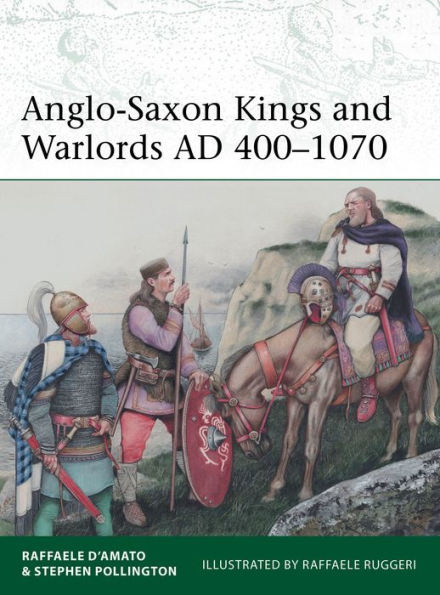Richly illustrated, this title describes Anglo-Saxon monarchs, warlords and their warriors and households in Anglo-Saxon Britain, from the first post-Roman mercenaries to the Norman Conquest.
In a country fragmented by Roman withdrawal during the 5th century AD, the employment of Germanic mercenaries by local rulers in Anglo-Saxon Britain was commonplace. These mercenaries became settlers, forcing Romano-British communities into Wales and the West Country. Against a background of spreading Christianity, the struggles of rival British and Anglo-Saxon kingdoms were exploited by the Vikings, but eventually contained by the Anglo-Saxon king, Alfred of Wessex. His descendants unified the country during the 10th century, however, subsequent weak rule saw its 25-year incorporation into a Danish empire before it finally fell to the Norman invasion of 1066.
Scholars of the early Church have long known that the term 'Dark Ages' for the 5th to 11th centuries in Britain refers only to a lack of written sources, and gives a false impression of material culture. The Anglo-Saxon warrior elite were equipped with magnificent armour, influenced by the cultures of the late Romans, the Scandinavian Vendel people, the Frankish Merovingians, Carolingians and Ottonians, and also the Vikings.
In this volume, co-authors Raffaele D'Amato and Stephen Pollington access their extended knowledge to paint a vivid picture of the kings and warlords of the time with the aid of colour illustrations, rare photos and the latest archaeological research.
"1142827027"
In a country fragmented by Roman withdrawal during the 5th century AD, the employment of Germanic mercenaries by local rulers in Anglo-Saxon Britain was commonplace. These mercenaries became settlers, forcing Romano-British communities into Wales and the West Country. Against a background of spreading Christianity, the struggles of rival British and Anglo-Saxon kingdoms were exploited by the Vikings, but eventually contained by the Anglo-Saxon king, Alfred of Wessex. His descendants unified the country during the 10th century, however, subsequent weak rule saw its 25-year incorporation into a Danish empire before it finally fell to the Norman invasion of 1066.
Scholars of the early Church have long known that the term 'Dark Ages' for the 5th to 11th centuries in Britain refers only to a lack of written sources, and gives a false impression of material culture. The Anglo-Saxon warrior elite were equipped with magnificent armour, influenced by the cultures of the late Romans, the Scandinavian Vendel people, the Frankish Merovingians, Carolingians and Ottonians, and also the Vikings.
In this volume, co-authors Raffaele D'Amato and Stephen Pollington access their extended knowledge to paint a vivid picture of the kings and warlords of the time with the aid of colour illustrations, rare photos and the latest archaeological research.
Anglo-Saxon Kings and Warlords AD 400-1070
Richly illustrated, this title describes Anglo-Saxon monarchs, warlords and their warriors and households in Anglo-Saxon Britain, from the first post-Roman mercenaries to the Norman Conquest.
In a country fragmented by Roman withdrawal during the 5th century AD, the employment of Germanic mercenaries by local rulers in Anglo-Saxon Britain was commonplace. These mercenaries became settlers, forcing Romano-British communities into Wales and the West Country. Against a background of spreading Christianity, the struggles of rival British and Anglo-Saxon kingdoms were exploited by the Vikings, but eventually contained by the Anglo-Saxon king, Alfred of Wessex. His descendants unified the country during the 10th century, however, subsequent weak rule saw its 25-year incorporation into a Danish empire before it finally fell to the Norman invasion of 1066.
Scholars of the early Church have long known that the term 'Dark Ages' for the 5th to 11th centuries in Britain refers only to a lack of written sources, and gives a false impression of material culture. The Anglo-Saxon warrior elite were equipped with magnificent armour, influenced by the cultures of the late Romans, the Scandinavian Vendel people, the Frankish Merovingians, Carolingians and Ottonians, and also the Vikings.
In this volume, co-authors Raffaele D'Amato and Stephen Pollington access their extended knowledge to paint a vivid picture of the kings and warlords of the time with the aid of colour illustrations, rare photos and the latest archaeological research.
In a country fragmented by Roman withdrawal during the 5th century AD, the employment of Germanic mercenaries by local rulers in Anglo-Saxon Britain was commonplace. These mercenaries became settlers, forcing Romano-British communities into Wales and the West Country. Against a background of spreading Christianity, the struggles of rival British and Anglo-Saxon kingdoms were exploited by the Vikings, but eventually contained by the Anglo-Saxon king, Alfred of Wessex. His descendants unified the country during the 10th century, however, subsequent weak rule saw its 25-year incorporation into a Danish empire before it finally fell to the Norman invasion of 1066.
Scholars of the early Church have long known that the term 'Dark Ages' for the 5th to 11th centuries in Britain refers only to a lack of written sources, and gives a false impression of material culture. The Anglo-Saxon warrior elite were equipped with magnificent armour, influenced by the cultures of the late Romans, the Scandinavian Vendel people, the Frankish Merovingians, Carolingians and Ottonians, and also the Vikings.
In this volume, co-authors Raffaele D'Amato and Stephen Pollington access their extended knowledge to paint a vivid picture of the kings and warlords of the time with the aid of colour illustrations, rare photos and the latest archaeological research.
12.99
In Stock
5
1

Anglo-Saxon Kings and Warlords AD 400-1070
64
Anglo-Saxon Kings and Warlords AD 400-1070
64eBook
$12.99
$16.80
Save 23%
Current price is $12.99, Original price is $16.8. You Save 23%.
Related collections and offers
12.99
In Stock

Product Details
| ISBN-13: | 9781472855343 |
|---|---|
| Publisher: | Bloomsbury Publishing |
| Publication date: | 10/26/2023 |
| Series: | Elite , #253 |
| Sold by: | Barnes & Noble |
| Format: | eBook |
| Pages: | 64 |
| File size: | 15 MB |
| Note: | This product may take a few minutes to download. |
About the Author
From the B&N Reads Blog
